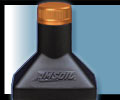Offers superior film retention, providing
long-term protection against corrosion and dry starts,
extending engine life and reducing operating expenses.
Its aerosol spray formulation offers easy and clean
applications, while reaching more components and offering
better distribution than straight motor oil.
Two- and four-stroke recreational
vehicles, hand held power equipment, small engines,
construction and farm equipment are commonly operated
seasonally or infrequently, then stored for long
periods of time. During these periods of inactivity,
and as a result of fluctuations in ambient temperatures,
water vapor can form condensate within the engine.
When this condensate comes into direct contact
with steel and iron components, it forms surface
corrosion on cylinder liners, piston rings, anti-friction
bearings and steel/iron contact surfaces on rotational
seals. Long periods of storage can also dry out
cylinders, often resulting in permanent damage
when the equipment is taken out of storage and
dry started.
The severity of component distress
resulting from extended storage varies, but it
is usually not enough to result in immediate component
failure. Often, equipment appears to function
properly when put back into service, failing shortly
thereafter as component distress increases with
use. Because the failure doesn’t happen immediately,
the equipment owner often does not suspect storage-related
problems.
The industry is beginning to
recognize the relationship between storage-related
corrosion and premature engine failures and performance
problems. Most two- and four-stroke motor oils
are formulated to have an affinity to engine component
surfaces, acting as a barrier that keeps condensate
from contacting engine components and forming
corrosion. However, the effectiveness of motor
oil in this area diminishes with time.
Two common methods are used to
extend protection of stored components. One method
involves placing motor oil directly on internal
engine components, usually by pouring one or two
ounces of oil into the engine cylinders through
the spark plug holes and manually rotating the
engine to distribute the oil. The more effective,
easier and cleaner method involves use of an aerosol
fogging oil. Because it can be applied through
the engine intake or carburetor as it is running,
a fogging oil reaches and protects more components
than a straight motor oil. In addition, the aerosol
nature of fogging oil offers a more complete distribution
of the oil than the straight motor oil method,
something especially beneficial in applications
with horizontal cylinder orientation, such as
outboard motors.
A survey of manufacturers in
the affected market reveals all have maintenance
guidelines for long-term storage of equipment.
Forty-three percent indicated special maintenance
is required if length of anticipated equipment
inactivity exceeds 30 days, while 43 percent indicated
a time period of 60 days and 14 percent indicated
a time period of 90 days. All recommended the
application of additional oil to the engine for
long-term storage, and more than half suggested
the use of a special fogging oil.
New AMSOIL Engine Fogging Oil
offers superior film retention, providing long-term
protection against corrosion and dry starts, extending
engine life and reducing operating expenses. Its
aerosol spray formulation offers easy and clean
applications, while reaching more components and
offering better distribution than straight motor
oil.
AMSOIL Engine Fogging Oil applications
include, but are not limited to, motorcycles,
snowmobiles, ATV’s, outboard motors, stern
drive and inboard marine engines, personal watercraft,
lawn equipment, chainsaws, snowblowers, portable
generators, hand held power equipment, motor scooters,
powered farm equipment, powered construction equipment,
cars and trucks.



